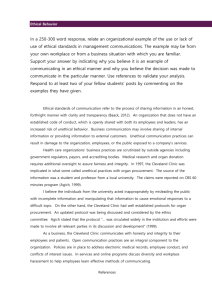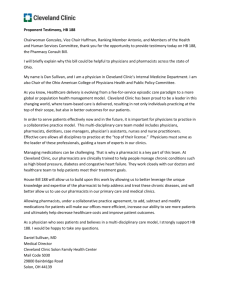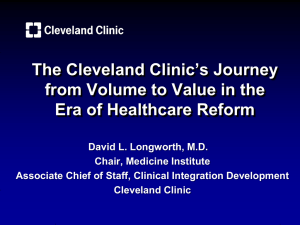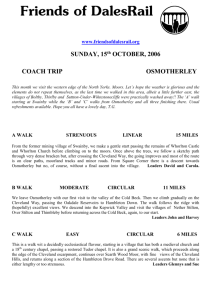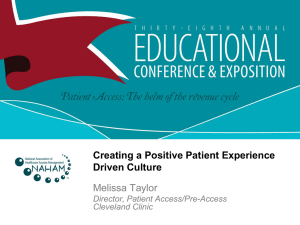A Healthcare Model for the 21st Century
advertisement
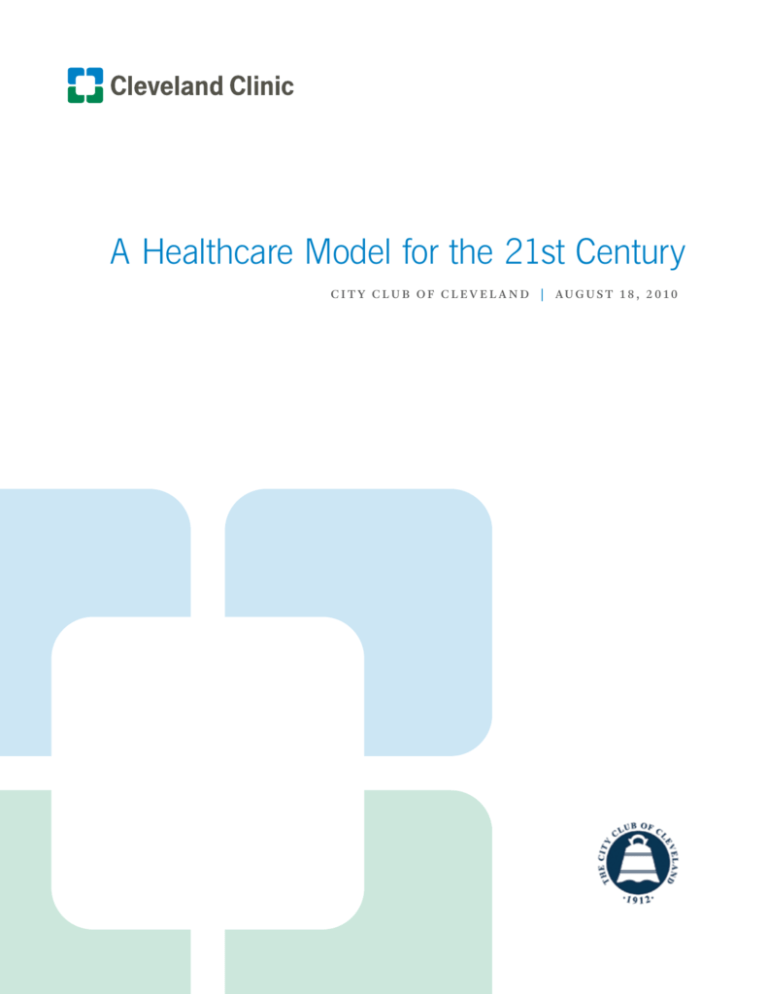
A Healthcare Model for the 21st Century C i t y C l u b of C l e v e l a n d | Au g u s t 18 , 2 010 A Healthcare Model for the 21st Century D e l o s M . C o s g r o v e , M D | C EO a n d P r e s i d e n t | C l e v e l a n d C l i n i c It is an honor to be invited here today. The City Club Forum has always been an outstanding platform for the discussion of important issues. In the Fifth Century BC, Heraclitus observed that We are treating a different mix of diseases today than in the past. Infant mortality has decreased by ninety-five percent. Devastating infectious diseases like tuberculosis and polio have been virtually eliminated. Life expectancy has gone up to seventy-eight years. nothing is permanent but change. Healthcare is We’re seeing more patients who are sixty-five and changing. I’d like briefly to outline these changes, and older. This number is set to explode to more than discuss the effect on patients, diseases, treatments, fifty million people over the next ten years. As life delivery systems, caregivers and, finally, costs. expectancy goes up, the causes of disease and Healthcare and the economy are in the midst of historic realignments. Cleveland Clinic needs to innovate and evolve if we are to continue to serve our patients and remain an economic engine for the region. Let me begin with a look at the changes in our own community. The city of Cleveland has shrunk dramatically over the past sixty years. The population has fallen – from nine hundred thousand to less than four hundred thousand. Cuyahoga County has seen similar but less dramatic change. The population has dropped from 1.7 million to less than 1.3 million. 2 | A Healthcare Model for the 21st Century death are changing. Chronic diseases of aging were only three of the six major causes of death in 1960. Today, they are six of the seven major causes of death. Alzheimer’s disease is now more common than diabetes. There are five million cases today. That number will nearly triple by 2050. The epidemic of obesity that began in the 1980s continues to sweep across our nation. Only twenty years ago, no state had more than fifteen percent obesity. Today, no state has less than fifteen percent obesity. Thirty percent of the United States is not simply overweight but obese. Ohio is the fifteenth most obese state in the nation. Obesity increases the incidence of diabetes, heart disease, 1952, and Doctors Hospital moved to become high blood pressure, and joint problems. It is Hillcrest Hospital in 1968. ironic that obesity could wipe out recent longevity gains. Our children may not live as long as we do. The changing demographics have caused fifty Cleveland Catholic churches to close. Sixty-six Cleveland We have seen radical changes in medical technol- Metropolitan School District facilities have closed. ogy. The new treatments are staggeringly sophisti- Hospitals have responded in a similar fashion. Since cated and remarkably successful. Even those of us 1970, fourteen hospitals have closed or merged. in the medical profession are startled by this new technology, which is increasingly aimed at older patients and those with chronic diseases. But hospitals have seen more drastic changes than churches and schools. The average hospital stay has been reduced by three days. New tech- Joint replacement used to be rare and risky. Today, niques have transformed surgery. The majority of it’s safe and common, and done almost 1.6 million all surgeries are now ambulatory. More patients times a year. Organ transplantation was unknown are being treated at home. Over the past decade, in 1960. Today, it’s a daily, and a nightly, occur- Medicare homecare costs have doubled to eigh- rence. More than seventy-two thousand Americans teen billion dollars. had tissue transplants in 2009. Doctors’ offices have seen a revolution in the past We’re exploring the frontiers of neurosurgery. Deep quarter century. Outpatient visits have grown by brain stimulation is being used to treat neurode- two hundred percent. generative diseases like Parkinson’s and behavioral disorders like depression and drug addiction. The center of gravity is shifting away from the hospital. Outpatient care has replaced hospital Thirty percent of premature deaths are related to care, and outpatient care is being replaced by genetics. On the horizon is genomic medicine with homecare. Patients want treatment and recovery vast potential for prediction and prevention. in a normal environment. Cleveland Clinic serves the community through This is a permanent national trend. Two hundred nine regional hospitals. These hospitals include thousand hospital beds have been eliminated in some of the oldest medical facilities in Cleveland. the United States over the past twenty-five years. They are profoundly affected by changes in population and technology. Cuyahoga County lags the nation in this regard. We have more hospital beds per person than al- Many of our regional hHospitals are aging out of most any city in the country. We have added beds, their usefulness. Some operating rooms are too even though hospital admissions are flat. This small for modern surgical equipment and need affects hospital occupancy. to be modernized to current standards. Hospitals work most efficiently at about eighty-five Hospitals have historically moved to follow the percent occupancy. Local occupancy fell over the population. The founders of Cleveland Clinic last four years from seventy-four percent to sixty- moved their medical offices from downtown to eight percent this year. New beds will be added in East 93rd and Euclid Avenue in 1921. Glenville 2011 that will drop occupancy to sixty-six percent. Hospital moved to become Euclid Hospital in A Healthcare Model for the 21st Century | 3 Healthcare has moved from an individual prac- Cleveland Clinic was founded by innovators and tice to a team sport, and the solo practitioner is medical pioneers. In 1921 at the dedication of becoming a historic figure. Cleveland Clinic, its founder George Crile stated Cleveland Clinic started with small teams. Our Department of Thoracic and Cardiovascular Surgery had two surgeons in 1956 and a handful of nurses that “our institution is designed to meet what we believe to be a public need in a more flexible organization.” and technicians. Today, the cardiac team includes Cleveland Clinic has an innovative structure. It is hundreds of physicians and support personnel. a not-for-profit group practice with physician lead- As procedures and care become more complicated, teams require more specialties. ership. All physicians are on salary. There are no bonuses or financial incentives. All physicians are subject to annual performance reviews and are on The recent face transplant at Cleveland Clinic is a one-year contract. To date, I personally have had an outstanding example of teamwork. There were thirty-five one-year contracts. eleven specialties involved, including bioethics and psychiatry. The motto of this group practice is “to act as a unit.” Its success can be measured by our growth. Teamwork is changing the face of physician We now have two thousand seven hundred sala- employment. Solo practitioners are challenged ried physicians and scientists – the second largest by the explosion of medical knowledge and the group practice in the world. complexity of running a business. Last year for the first time, more physicians were employed by hospitals than worked for themselves. We continue to innovate our delivery system. Three years ago, we changed our organizational structure from the typical profession-oriented The recent healthcare debate has highlighted organization designed around physician compe- the skyrocketing cost of healthcare in the United tencies, such as surgery, to a patient needs-oriented States. Healthcare costs were more than seventeen approach such as the Heart and Vascular Institute. percent of the GDP in 2010 and will shoot up to We are the only hospital to be completely organized eighteen percent next year. around patient needs. Average individual spending grew remarkably to Each institute is based around a single organ eight thousand dollars per person in 2009. This system or disease. Medical and surgical services has sent the cost of employee insurance premiums are combined under single leadership in a com- through the roof. The average family is paying four mon location. Our Heart & Vascular Institute thousand dollars per year. Clearly, this growth rate includes cardiac surgeons, cardiologists, and is unsustainable. vascular surgeons, all co-located in the Sydell We are facing new challenges. The old solutions and Arnold Miller Family Pavilion. won’t work. Michael Porter, professor at Harvard Institutes put “patients first.” They promote Business School, wrote: “Innovation is the only innovation and the efficient use of resources. true long term solution to high quality, afford- They represent teamwork at its best to solve able healthcare.” complicated problems. 4 | A Healthcare Model for the 21st Century The demand for doctors is growing nationwide The system has multiple tiers. Each tier is a step as people are getting older. More people will have up in complexity and acuity. coverage through healthcare reform. It’s estimated that America will need eight hundred sixty thousand doctors to meet its medical needs by 2025. But projections show we won’t have anywhere near that number. The supply will fall one hundred twentyfive thousand short. We’ll need to rely on mid-level providers – nurse practitioners, physician assistants, and certified registered nurse anesthetists. Cleveland Clinic has a forty-year tradition of using mid-level providers. We have eighty mid-level providers supplementing physician care in cardiac surgery alone. We’re experimenting with other ways to extend physician services. Shared appointments are an innovative way to fill the gap. These visits begin with the The next level is our sixteen Family Health and Surgery Centers. They offer primary and specialty care, and same-day surgeries across the region. We are in the process of building two new facilities to serve Avon and Twinsburg. We’re particularly proud of the Huron Community Health Center we’re building in East Cleveland. This concept was developed with community leaders, and it represents the leading edge of chronic disease care. It’s planned to meet the special needs of this urban community and reduce the need for hospitalization. Our nine Cleveland Clinic regional hospitals provide routine hospital care for their communities. patient seeing the doctor alone, followed by a group The main campus of Cleveland Clinic is the upper session with patients who have the same condition. tier of the system. It has become a very high-tech Shared visits are an excellent resource for patients facility to treat complicated conditions of very ill with diabetes and other chronic conditions. patients. Currently, its patients have the highest There is a worldwide shortage of nurses. The US average case severity in the nation. nursing deficit is expected to be one million by All of our facilities are virtually linked through 2020. We are relying more and more on technicians an electronic medical records system serving six to take up the slack. This has been very successful. million patients. It is possible to have your medi- At Cleveland Clinic, technicians now perform forty cal record go electronically from a family health percent of nursing labor in the operating room. center to a community hospital to main campus One of the biggest operational challenges in healthcare is to align locations with patient needs. This means having the right facility at the right time for and back. President Obama noted that, “Cleveland Clinic has one of the best health information systems in the country.” the right care. Cleveland Clinic’s answer to this This virtual network is matched by a patient challenge is our integrated delivery system. This transportation network that can go anywhere in system provides the full spectrum of care, utilizing the world. We have ambulances, helicopters and one hundred fifteen locations. fixed-wing aircraft. They transferred twelve thou- The simplest unit of the system is the Minute Clinic. We have nine Minute Clinics at local pharmacies, supported by Cleveland Clinic personnel. sand patients last year to the main campus. This included patients from thirty-five states and sixteen different nations. They offer basic care for minor ailments. A Healthcare Model for the 21st Century | 5 We are utilizing resources more efficiently and have At that time, Ohio will have the second highest consolidated several services to create centers of spending related to obesity. excellence. Not all hospitals can be all things to all people. We consolidated obstetrics from six hospitals to five centers of excellence. Inpatient rehabilitation We think it is important that we move from “sick care” to “health care.” has gone from five to three hospitals. We went into Systematically, Cleveland Clinic has developed partnership with MetroHealth Medical Center to de- a model to help communities reduce the burden velop the Northern Ohio Regional Trauma Network. of disease. This has improved trauma care across the region and enabled us to eliminate one trauma hospital. We began by adopting a no smoking policy for all Ultimately, healthcare systems will be judged, like thousand other companies in the US by not hiring most things, on the value they deliver by producing smokers. In an attempt to benefit the community, high quality care at a lower cost. We can do this. we offered a free program of smoking cessation to Cleveland Clinic quality is recognized around the world. U.S.News & World Report ranks us fourth in the nation on its honor roll of “Best Hospitals.” At Cleveland Clinic fourteen of the sixteen specialties were ranked in the top ten nationally. To further drive quality, it is critically important to develop, measure and report quality metrics. Five years ago each institute began publishing quality reports, which are also available on our website. of our campuses. We next followed the lead of six all citizens of Cuyahoga County. These efforts contributed to a remarkable change over a five year period. During that time, smoking across the US was at twenty percent; smoking in Ohio decreased to twenty-four percent. In a five-year period, Cuyahoga County smoking incidences fell from twenty-eight percent to eighteen percent. This demonstrates that it is possible to have a major influence on the health of the community. This exercise promotes self analysis, transparency, Encouraged by this, we began to attack the epi- and quality improvement. demic of obesity. Forty healthy changes were made The Dartmouth Atlas recently held up Cleveland Clinic as the model for delivering high quality, low cost care. The Mayo Clinic and Cleveland Clinic, which share the same model of healthcare delivery, were the two leaders in low cost chronic care. If we are to reduce costs, not only must we further refine and coordinate our delivery system, we must also reduce the burden of disease in the US. in the foods served to our patients and employees. Transfats were removed from all food and recently, sugared drinks were removed from cafeterias and vending machines. Exercise and healthy diet were encouraged with free memberships in Curves,™ Weight Watchers,™ our fitness centers and yoga classes for our employees. An extensive weight management program developed for our employees, has helped them The major causes of premature death in the US lose more than one hundred sixty thousand are related to personal behavior. These include obe- pounds over the last year and a half. sity, sedentary lifestyle, and smoking. Obesity alone accounts for ten percent of US healthcare costs and is expected to reach twenty-one percent by 2018. 6 | A Healthcare Model for the 21st Century This effort was extended to the community in partnership with the YMCA and Curves. Response was overwhelming, and the results gratifying. To ensure our future success as a vibrant and growing international healthcare delivery system, we will continue to put our patients first. We will hold ourselves to our founders’ values. We will take risks with our ideas. We will be creative and continue to drive innovation. We will continue as an important and growing economic engine for this region and the state. – Delos M. Cosgrove, MD Ten thousand people participated and lost We must think and act anew in responding to the twenty-five thousand pounds in three months. challenge of providing high quality, coordinated Cleveland Clinic believes in Cleveland and is dedicated to the welfare of its citizens. We are committed to a healthy environment. To help lead the sustainability effort, all buildings recently completed or currently under construction will receive LEED certification. Solar panels have been added to the roofs of our buildings. Our energy use index has improved secondary to multiple aggressive moves. Our recycling program has now exceeded our initial goal, and we are headed toward recycling fifty percent of our waste. Our community benefit value continues to increase. healthcare for the citizens of Northeast Ohio, at lower cost. To ensure our future success as a vibrant and growing international healthcare delivery system, we will continue to put our patients first. We will hold ourselves to our founders’ values. We will take risks with our ideas. We will be creative and continue to drive innovation. We will continue as an important and growing economic engine for this region and the state. We have the vision to think anew and the courage to act anew. This includes clinical services, charity care, research, I have described to you today the unique health- education, and shortfall in Medicaid payments. care delivery system that has been recognized as It reached half a billion dollars in 2009, the largest a model for the nation. Forty thousand Cleveland in Ohio. Clinic employees are privileged to serve the On the eve of the Civil War, Abraham Lincoln addressed Congress saying that, “The occasion is citizens of Northeast Ohio and the nation, and are appreciative of the opportunity. piled high with difficulties and we must rise to the occasion. We must think anew and act anew.” Thank you for your attention. A Healthcare Model for the 21st Century | 7 Every life deserves world class care.

